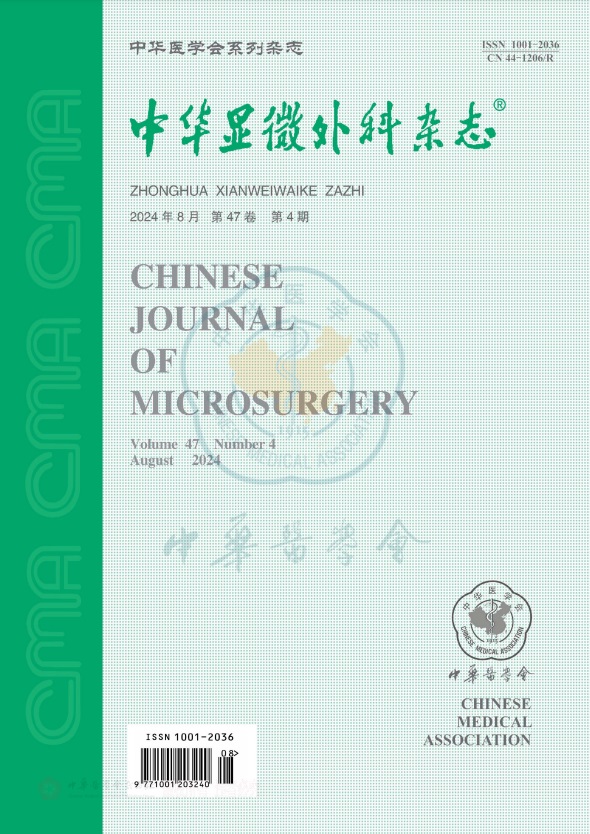Microsurgical repair of soft tissue necrosis after beak-type calcaneal fracture in 8 cases
引用次数: 0
Abstract
Objective To investigate the clinical efficacy of microsurgical repair of soft tissue necrosis after beak-type calcaneal fracture. Methods From January, 2012 to March, 2017, surgically flaps were used to repair wounds in 8 patients with soft tissue necrosis after calcaneal beak fracture. Five patients underwent sural neurovascular flap in the first stage of repair, 2 patients were treated with peroneal perforator propeller flap, and 1 patient was treated with posterior tibial artery perforator propeller flap. The donor sites of 3 flaps were directly closed, and donor areas of the remaining 5 were covered with medium-thickness skin grafts without being sutured directly. The size of flap was 5.0 cm × 3.0 cm-7.0 cm × 5.0 cm. Through postoperative outpatient and WeChat follow-up. The patient’s flap survival, infection, flap shape, sensation and ankle function were evaluated. Results All flaps and skin grafts survived post-operatively. All patients were followed-up for 6-12 (mean, 8.4) months. All patients had good flap survival and no complications such as soft tissue and calcaneal infection. The flaps were good in texture, shape and function of ankle. At the last follow-up, according to the British Medical Research Institute (BMRI), the sensory function was divided into 6 levels. The flap sensory function recovered to S2 in 3 cases, and the remaining 5 cases was S1. According to the American Orthopedic Foot and Ankle Society (AOFAS) Ankle-hindfoot Scale (AHS), the results were excellent in 5 cases, and good in 3 cases. All patients had good clinical results and satisfaction at the last followed-up. Conclusion The treatment of soft tissue necrosis after calcaneus beak fractures can be completed in one stage by using flaps, which avoided the occurrence of calcaneal osteomyelitis. It is easy to perform early rehabilitation exercise and the ankle function is well restored. Key words: Calcaneus; Beak fracture; Propeller flap; Sural neurovascular flap; Microsurgical technique跟骨喙型骨折后软组织坏死的显微外科修复8例
目的探讨显微外科治疗喙型跟骨骨折后软组织坏死的临床疗效。方法自2012年1月至2017年3月,对8例跟骨喙部骨折后软组织坏死患者采用手术皮瓣修复创面。5例患者在修复的第一阶段接受了腓肠神经血管皮瓣,2例患者接受了腓动脉穿支螺旋桨皮瓣治疗,1例患者接受胫后动脉穿支螺旋皮瓣治疗。3个皮瓣的供区直接闭合,其余5个皮瓣的供体区用中厚皮片覆盖,不直接缝合。皮瓣大小为5.0cm×3.0cm~7.0cm×5.0cm。对患者的皮瓣成活率、感染率、皮瓣形状、感觉和踝关节功能进行评估。结果术后皮瓣和皮片全部成活。所有患者随访6-12个月(平均8.4个月)。所有患者皮瓣成活率良好,无软组织和跟骨感染等并发症。皮瓣质地、形态、功能良好。根据英国医学研究所(BMRI)的数据,在最后一次随访中,感觉功能分为6个级别。3例皮瓣感觉功能恢复到S2,其余5例为S1。根据美国足踝矫形学会(AOFAS)踝后足量表(AHS),结果优5例,良3例。所有患者在最后一次随访中均取得了良好的临床效果和满意度。结论跟骨喙部骨折后软组织坏死的治疗可采用皮瓣一次性完成,避免了跟骨骨髓炎的发生。进行早期康复训练很容易,踝关节功能恢复良好。关键词:跟骨;Beak骨折;螺旋桨襟翼;Sural神经血管皮瓣;显微外科技术
本文章由计算机程序翻译,如有差异,请以英文原文为准。
求助全文
约1分钟内获得全文
求助全文
来源期刊
CiteScore
0.50
自引率
0.00%
发文量
6448
期刊介绍:
Chinese Journal of Microsurgery was established in 1978, the predecessor of which is Microsurgery. Chinese Journal of Microsurgery is now indexed by WPRIM, CNKI, Wanfang Data, CSCD, etc. The impact factor of the journal is 1.731 in 2017, ranking the third among all journal of comprehensive surgery.
The journal covers clinical and basic studies in field of microsurgery. Articles with clinical interest and implications will be given preference.

 求助内容:
求助内容: 应助结果提醒方式:
应助结果提醒方式:


